How often have you shopped using your phone this year? Even if you’re not constantly on your smartphone, it’s likely your top choice for quick purchases. This is backed by the numbers: mobile e-commerce sales keep growing every year.
From 2021 to 2022, the time people worldwide spent in e-commerce apps increased by 12%. This shift shows a clear move towards mobile-first shopping, highlighting the importance of mobile commerce technology. By 2025, it’s predicted that US mobile phone users will spend an average of 4 hours and 2 minutes per day on their devices. This makes mobile commerce development services more important than ever.
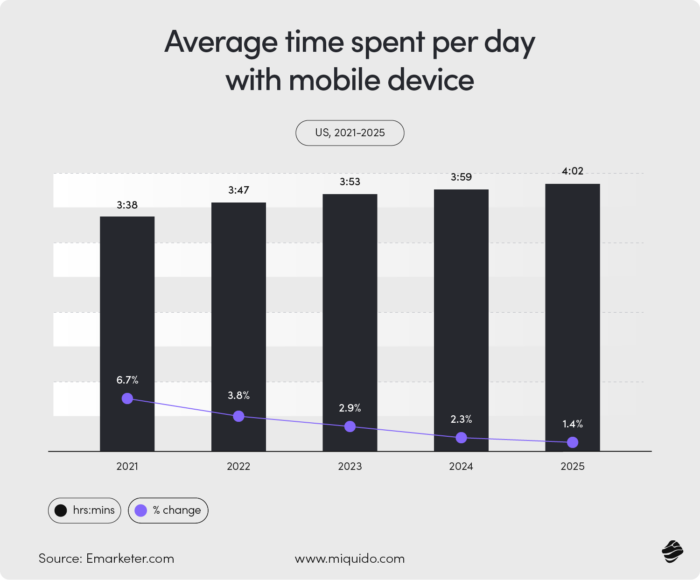
Mobile phones are dominating internet traffic globally, offering businesses a great chance to increase sales and improve their brand image using advanced mobile e-commerce technology. So, if you want to add advanced eCommerce app features and enhance the mobile shopping experience, now is the time to act.
However, with m-commerce technology changing so quickly, businesses must decide: should they go for native or cross-platform development? Each option has its pros and cons, and the right choice depends on your needs and goals.
In this article, we’ll explore the differences between native and cross-platform mCommerce development to help you make the best decision for your business.
P.S. If you want to learn first about what is mobile commerce, be sure to read our article.
Understanding key mobile commerce technology concepts
When developing mobile mCommerce apps, businesses face a key decision: should they choose native or cross-platform app development? This choice is crucial, as it affects user experience, customer satisfaction, and overall business success. Selecting the right mobile commerce technology approach can significantly influence the effectiveness of your mobile eCommerce strategy.
This section explores the core concepts of native and cross-platform mCommerce development. We’ll look at the pros and cons of each approach and key factors to consider when making your choice. By understanding these m-commerce technology concepts, you can make an informed decision that aligns with your business goals and enhances your e commerce app development strategy.
Native mCommerce development
Native development involves creating mobile apps specifically for a single platform, using that platform’s native programming languages and tools. For example, native iOS apps are developed using Swift or Objective-C, while native Android apps are built using Kotlin or Java. This approach is often favored when leveraging mobile commerce technology for optimal performance and user experience.
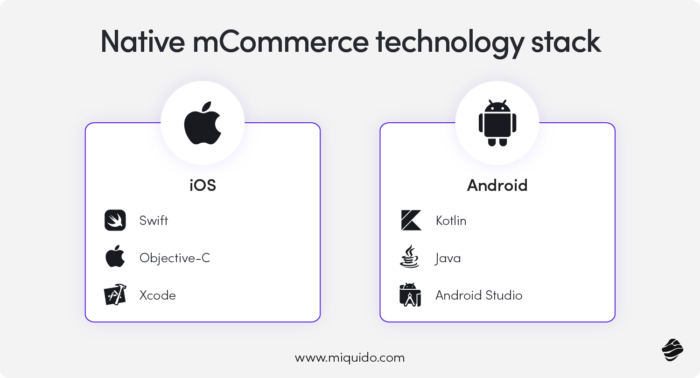
Technology Stack:
- iOS: Swift, Objective-C, Xcode
- Android: Kotlin, Java, Android Studio
Advantages:
- Performance: Native apps are generally faster and more responsive. They are optimized for the specific platform, allowing for efficient resource use and smoother performance, which is crucial in mobile e-commerce technology.
- User Experience: Native apps provide a superior user experience by using the platform’s native UI components and interactions. This results in a more intuitive and seamless interface that aligns with users’ expectations.
- Access to Device Features: Native development offers easier and more direct access to device-specific features like the camera, GPS, and sensors. This allows for creating more feature-rich and integrated applications using advanced m-commerce technology.
Disadvantages:
- Cost: Developing native apps for multiple platforms requires separate codebases and expertise, leading to higher development costs.
- Time: Maintaining separate codebases for each platform can result in longer development cycles and slower updates.
- Maintenance: Managing multiple codebases can be complex and time-consuming, requiring consistent updates and bug fixes across different platforms.
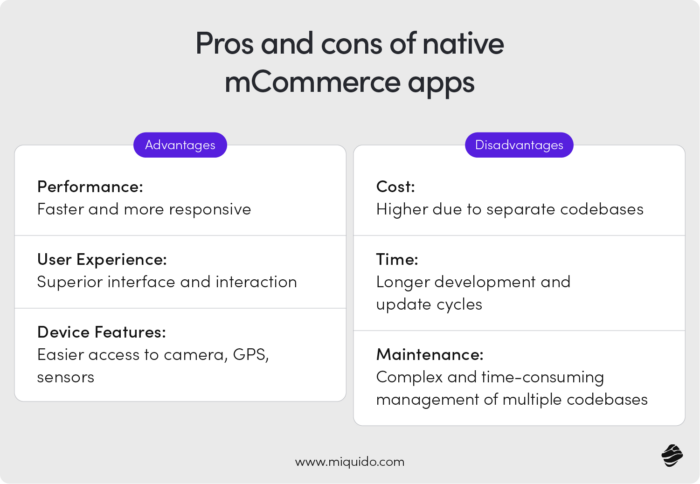
Cross-platform mCommerce development
Cross-platform development involves creating mobile apps that run on multiple platforms using a single codebase. This is done through frameworks that let developers write code once and deploy it across various platforms, like iOS and Android. This approach leverages mobile commerce technology to maximize reach and efficiency.
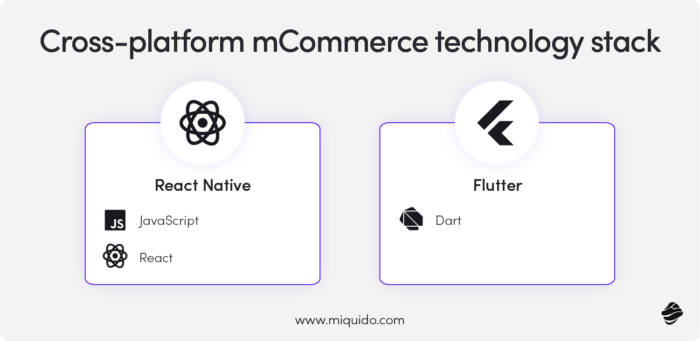
Technology Stack:
- React Native: A popular framework by Facebook that uses JavaScript and React.
- Flutter: A UI toolkit by Google that uses Dart.
Advantages:
- Cost-Effective: With a single codebase for multiple platforms, development costs are significantly lower than native development. This makes it an attractive option for businesses looking to implement mobile e-commerce technology on a budget.
- Faster Development: Cross-platform development speeds up time-to-market because you write code once and deploy it across multiple platforms. This efficiency is crucial for staying competitive in the rapidly evolving m-commerce technology landscape.
- Consistency: A single codebase ensures a uniform look and feel across different platforms, providing a consistent user experience. This uniformity is beneficial when deploying mobile commerce technology to a diverse audience.
Disadvantages:
- Performance: Cross-platform apps might not perform as well as native apps due to an additional layer of abstraction. They can be slower and less responsive, which can be a drawback for high-performance mobile e-commerce technology applications.
- User Experience: The user experience may not be as smooth or intuitive as native apps since cross-platform frameworks might not fully utilize native UI components. This can impact the overall effectiveness of your m-commerce technology strategy.
- Access to Device Features: Access to device-specific features can be limited or more complex, as cross-platform frameworks might not support all native APIs directly. This can lead to reduced functionality or increased development effort, posing challenges in fully leveraging mobile commerce technology.
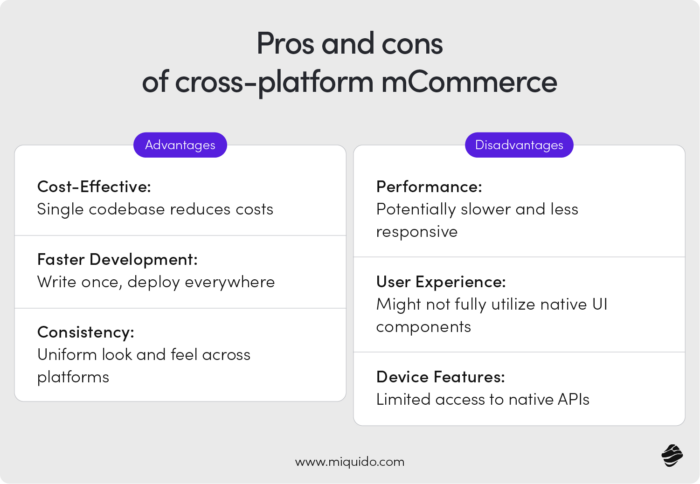
Key considerations in choosing technology for mobile devices
Before starting development, it’s crucial to map out your app’s blueprint. Understanding its features and purpose is key to making an informed decision. In today’s competitive market, businesses must consider the time-to-market factor, especially when implementing mobile technology.
Complex apps with extensive functionalities, especially groundbreaking ones, naturally require more resources. Are stunning visuals the main focus, or is functionality the priority? Businesses must consider numerous factors before developing an mCommerce app to ensure it meets their expectations, intentions, and resonates with customers. The choice between native and cross-platform development significantly impacts how effectively your mobile e-commerce technology strategy will perform.
Now, let’s explore the key seven considerations to guide your decision.
Development time
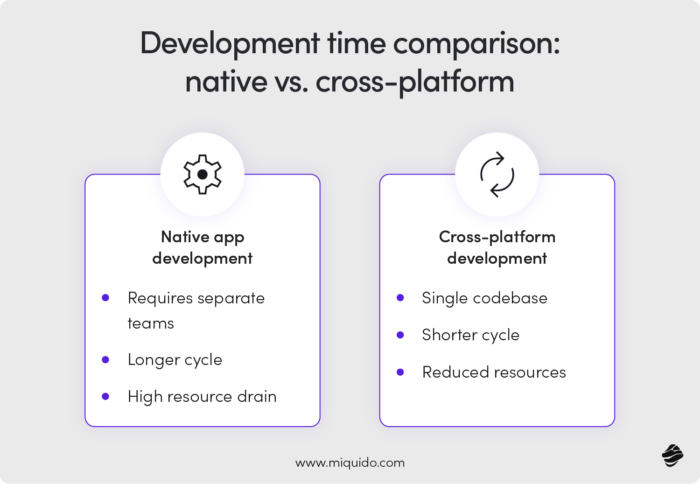
Developing native apps for both iOS and Android can significantly drain your resources. You’ll likely need separate development teams working in parallel, constantly syncing efforts to ensure a consistent user experience across both platforms. This results in a longer development cycle, which can be a major drawback for businesses aiming for a quick launch in the competitive world of mobile commerce technology.
Why choose cross-platform for faster development
Many companies are turning to cross-platform development to get their apps to market faster while keeping costs in check. Cross-platform development offers a shorter development cycle compared to native app development, making it a preferred approach in mobile e commerce technology.
Cross-platform development allows you to build and iterate quickly, getting your app into users’ hands sooner. This speedy launch means you can gather valuable user feedback early and make necessary adjustments. A single codebase reduces the need for multiple development teams, simplifying maintenance and updates, which is a significant advantage in m commerce technology.
In contrast, native app development is more time-consuming and requires more effort to maintain separate codebases. For businesses prioritizing a swift launch and rapid iteration, cross-platform development is the ideal choice in the rapidly evolving landscape of mobile commerce technology.
Mobile commerce technology cost
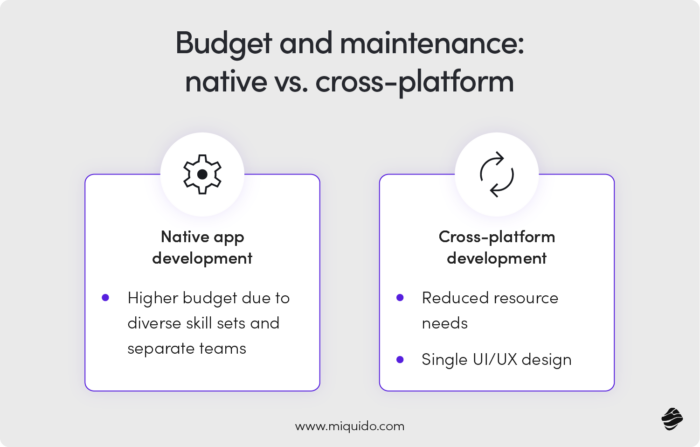
Building separate codebases for Android and iOS in mobile commerce technology requires a larger team with diverse skill sets. The development process needs developers proficient in platform-specific languages like Java/Kotlin for Android and Swift/Objective-C for iOS.
Depending on your app’s complexity, you might also need separate UI/UX designers for each platform to ensure adherence to platform-specific design guidelines. These factors lead to a higher overall budget for development and ongoing maintenance in the realm of mobile e commerce technology.
Cross-platform vs native development costs
Cross-platform development offers a more budget-friendly approach for m commerce technology. Utilizing a single codebase written in a framework language allows for deployment across both Android and iOS, translating to lower development costs. One codebase means less development time and potentially a smaller development team. Additionally, a single UI/UX design can often work for both platforms, further reducing resource needs.
However, it’s important to note that cross-platform development might not always deliver the same level of performance or customization as native development, especially for complex apps with intricate features. While it offers cost savings and faster time-to-market, the trade-offs in performance and customization need to be considered based on the specific needs of your app in the context of mobile commerce technology.
M commerce technology performance
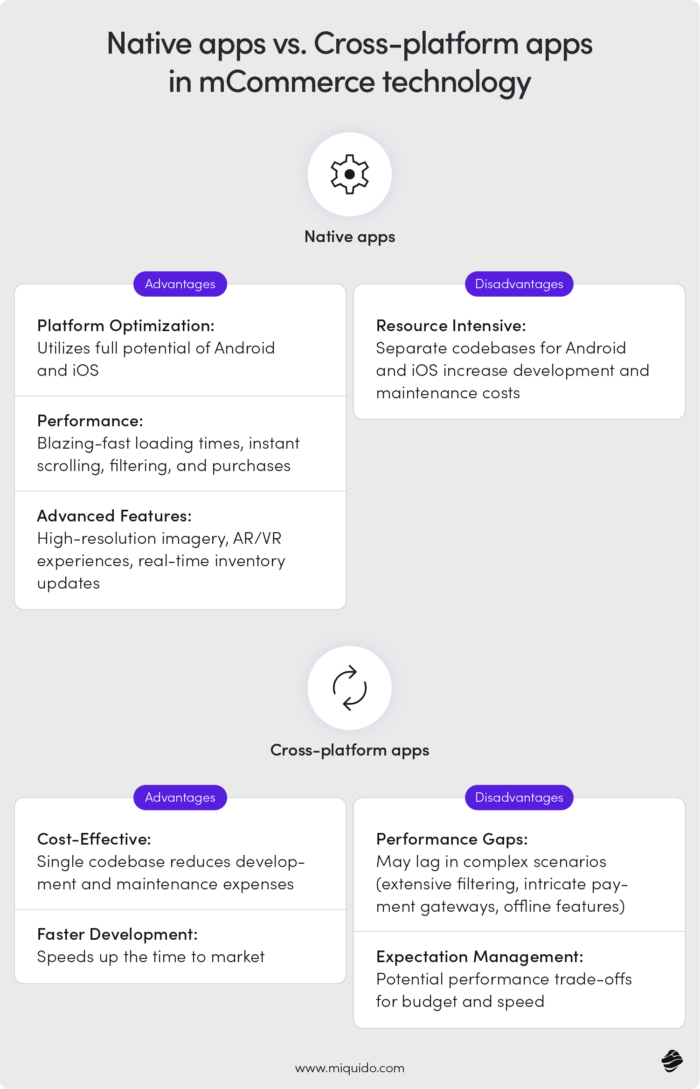
When it comes to mCommerce technology, native apps take the lead in performance. They leverage the full potential of each platform (Android and iOS) through platform-specific tools and optimizations. This translates to blazing-fast loading times, minimizing user frustration and wait times. Scrolling, filtering, and completing purchases occur instantaneously, creating a seamless and intuitive user experience in mobile commerce technology.
Additionally, native development empowers apps with enhanced capabilities like high-resolution product imagery, AR/VR experiences, and real-time inventory updates – all critical elements for success in the modern mobile e commerce technology landscape. However, this emphasis on performance comes at a cost. Building separate codebases for Android and iOS is a more resource-intensive approach, potentially leading to higher development and maintenance expenses.
The un(noticeable) difference between cross-platform and native performance
Regarding the performance of cross-platform mCommerce applications, there can still be a gap compared to native apps. This might be noticeable in complex scenarios involving extensive product filtering, intricate payment gateways, or demanding offline features.
Although the development of cross-platform technologies is constantly narrowing the gap, it’s important to manage expectations and weigh the potential performance trade-offs against the benefits of cross-platform development for your specific mCommerce technology app.
While cross-platform development offers a more budget-friendly and faster approach, the performance may not always match that of native apps, particularly for complex and feature-rich applications. This trade-off needs careful consideration based on the specific requirements and goals of your mCommerce technology app.
User interface and user experience
Native mCommerce apps offer complete control over the user interface (UI) and user experience (UX) in mobile commerce technology. They can leverage platform-specific design elements and gestures, ensuring a seamless experience that feels like an integral part of the operating system. This allows for highly customized UIs with intricate animations and interactions tailored to each platform. However, this level of customization requires separate UI/UX design teams for Android and iOS, potentially increasing development costs in the realm of mobile e commerce technology.
A single codebase for both platforms can limit UI customization
Cross-platform mCommerce apps prioritize efficiency by using a single codebase for both platforms. While this simplifies development, it can limit UI/UX customization, potentially leading to a less platform-specific feel compared to native apps. However, advancements in cross-platform frameworks in m commerce technology are blurring these lines, allowing for more platform-specific design elements in some cases.
The trade-off lies in potentially sacrificing some UI/UX customization for the benefits of faster development and potentially lower costs. While cross-platform apps may not always achieve the same level of UI/UX perfection as native apps, they offer a balanced approach that can still deliver a satisfactory user experience in the context of mobile commerce technology.
Security
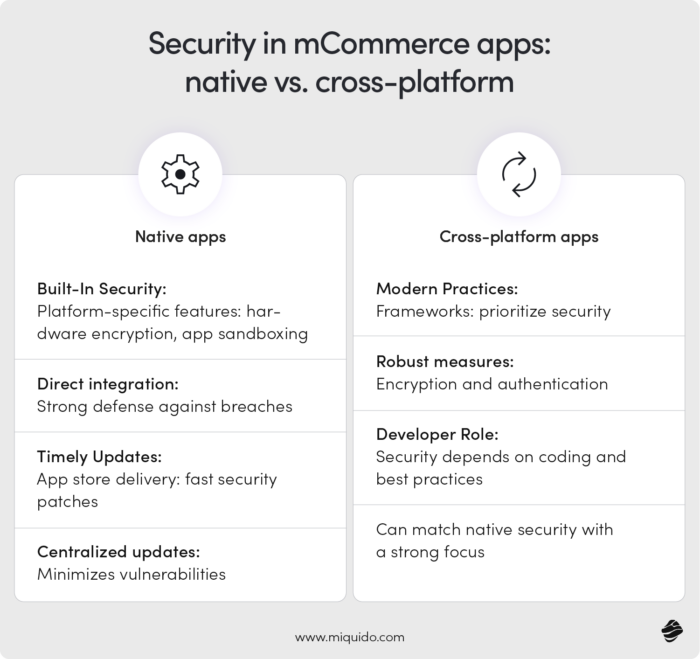
Native mCommerce apps rely on built-in security modules, integrating directly with platform-specific security features like hardware encryption and app sandboxing. This direct integration fortifies the app’s defenses against data breaches in mobile commerce technology. Additionally, updates delivered through the app stores ensure users receive the latest security patches promptly, minimizing the risk of users lingering on vulnerable versions. The centralized update process further enhances the security of native apps in the context of mobile e commerce technology.
Modern m commerce technology prioritizes security best practices
In a world dominated by mobile payment solutions like Google Pay and Apple Pay, ensuring the security of mCommerce applications is paramount. Cross-platform development in m commerce technology does not lag far behind in security. Modern frameworks prioritize security best practices, and developers can implement robust encryption and authentication measures within the codebase. With the widespread use of push notifications to engage users, it becomes even more critical to safeguard data and communications within mCommerce apps.While cross-platform apps might lack direct access to platform-specific security features, developers can still establish a strong security posture through careful coding.
Ultimately, the security of both native and cross-platform apps hinges on the development team’s skills and their commitment to implementing best practices.
A well-developed cross-platform mCommerce app can be just as secure as its native counterpart, provided it is built with a strong focus on security from the ground up in the landscape of mobile commerce technology.
Support & maintenance
Managing native m commerce apps can be a hassle due to the need for separate codebases for Android and iOS. This can double your development team’s workload and make dealing with platform-specific bugs and security issues more complicated in the realm of mobile commerce technology.
A better solution in mobile e commerce technology is cross-platform development, which uses a single codebase for both platforms. This means updates and bug fixes can be made once and rolled out to both Android and iOS users simultaneously.
This approach cuts down on maintenance costs and ensures that users get timely updates. While some platform-specific issues may still occur, overall support and maintenance in m commerce technology are much simpler compared to native development.
Exposure
Developing an mCommerce app just for iOS lets you focus on optimizing the experience for iPhone users. You can take advantage of Apple’s App Store optimization and specific features to boost visibility among iOS users in mobile commerce technology. This is great if your main audience uses iPhones.
However, you’ll miss out on the huge Android market, which makes up about 70% of global users, limiting your potential reach significantly in the mobile e commerce technology space.
Cross-platform development solves this problem in m commerce technology. With one codebase, you can launch your app on both Android and iOS at the same time. This way, you reach a much larger audience without the extra effort and cost of developing separate apps for each platform.
While you might need additional marketing to improve discoverability in each app store, you’ll still tap into both user bases, expanding your customer reach efficiently in the context of mobile commerce technology.
Future trends in mobile commerce technology development
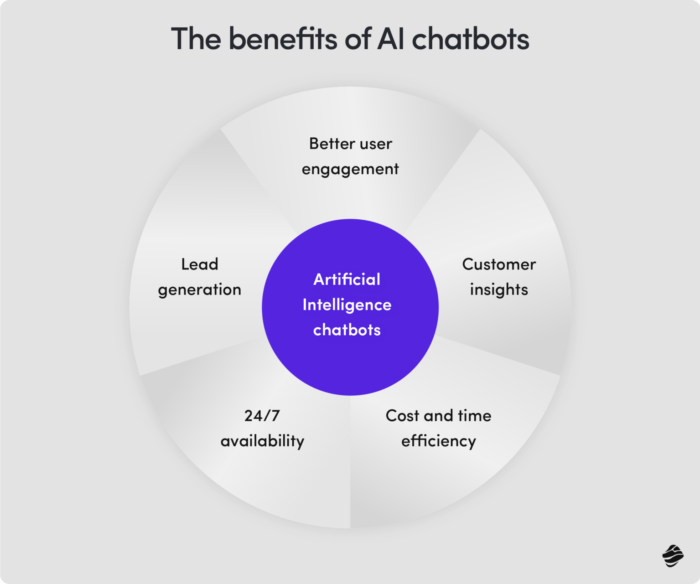
AI in eCommerce and ML are revolutionizing shopping apps by personalizing them for each user. Choosing between native and cross-platform development is key here. Native apps might better handle advanced AI and ML due to their optimized performance and seamless hardware integration. However, cross-platform tools are rapidly catching up, offering a cost-efficient way to reach a broader audience with these advanced features.
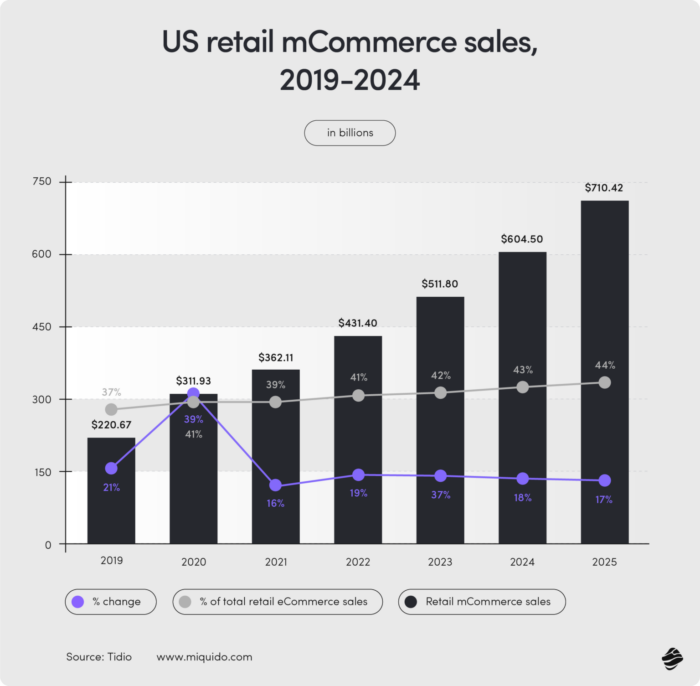
According to mobile commerce statistics for 2024, the growth in mobile shopping continues to surge, making it crucial for businesses to leverage AI and ML to enhance user experiences and stay competitive.
Enhancing user experience with augmented reality
AR is making waves in mCommerce, letting users see products in their real-world environment before buying. Native development is usually preferred for AR because it fully utilizes device-specific features, delivering top performance and user experience. But with tools like Flutter and React Native improving, cross-platform development is becoming a viable option for implementing AR, balancing innovation with cost management.
Mobile shopping is growing, influenced by the convenience and capabilities of mobile devices. This affects the choice between native and cross-platform development based on user expectations. Native apps offer superior performance and tailored experiences, ideal for high engagement on a specific platform. Cross-platform apps, on the other hand, provide consistency across devices, perfect for reaching a wider audience efficiently.
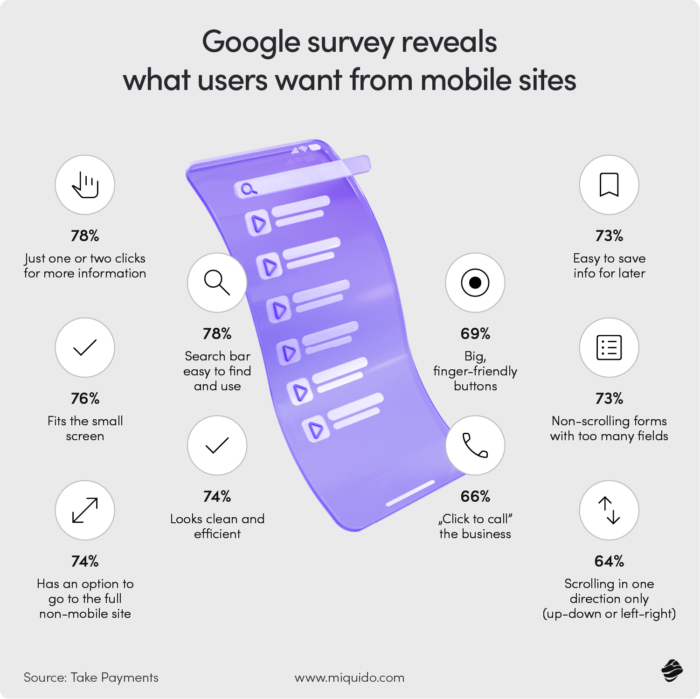
Addressing security and data privacy concerns
With mobile payments and digital wallets security and data privacy are critical.Native development often offers better control over security features, making it suitable for apps handling sensitive data. Cross-platform frameworks, however, are integrating advanced security measures, providing a good balance between security, faster development, and broader reach.
Embracing sustainability and ethical practices
Consumers are increasingly aware of sustainability and ethical practices. mCommerce apps need to highlight sustainable efforts and ensure transparency in sourcing and production. Native development allows for customized solutions to showcase these efforts, enhancing engagement with platform-specific features. Cross-platform development ensures a consistent message across all devices, amplifying the impact of sustainability practices.
By understanding how these emerging trends influence the choice between native and cross-platform mCommerce development, businesses can make strategic decisions that align with their goals and market demands. Staying ahead of these developments will be essential for maintaining a competitive edge and meeting the evolving expectations of consumers.
Making the right choice for your mCommerce success
Choosing between native and cross-platform development for your mCommerce app depends on several factors: development time, cost, performance, user experience, security, maintenance, and market exposure.
- Cross-Platform Development: Best for quick time-to-market and broad audience reach.
- Native Development: Ideal for superior performance and highly customized user experiences.
Assess your business needs carefully to make an informed decision that maximizes your app’s success. The benefits of mobile commerce are immense – but only staying ahead of trends and aligning with market demands will help maintain a competitive edge and meet evolving consumer expectations.

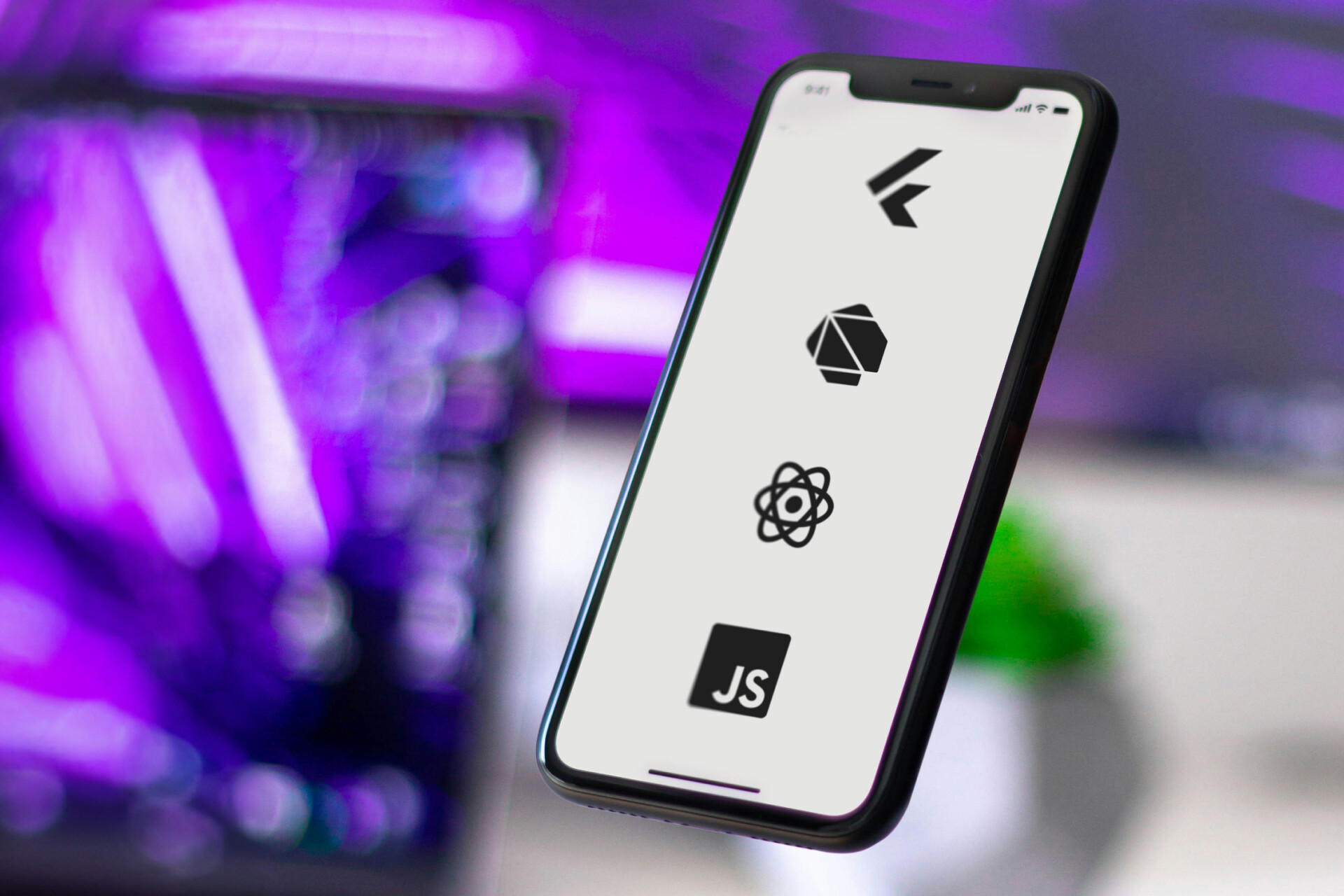






![[header] off the shelf vs. custom ecommerce software](https://www.miquido.com/wp-content/uploads/2020/05/header-off-the-shelf-vs.-custom-ecommerce-software-432x288.jpg)
